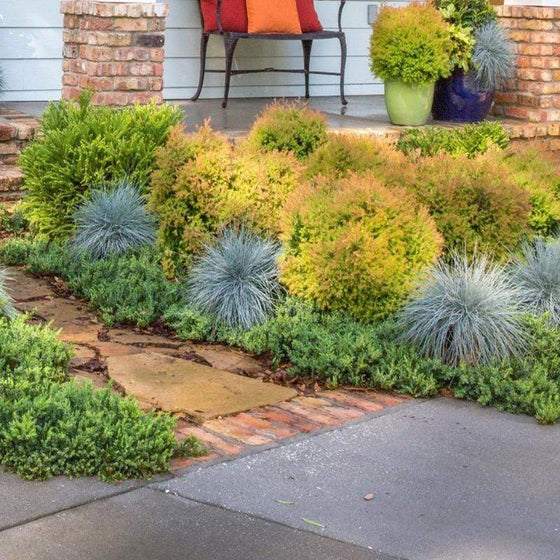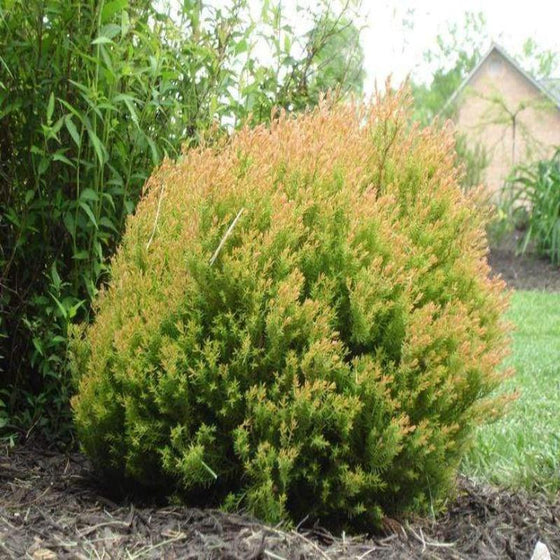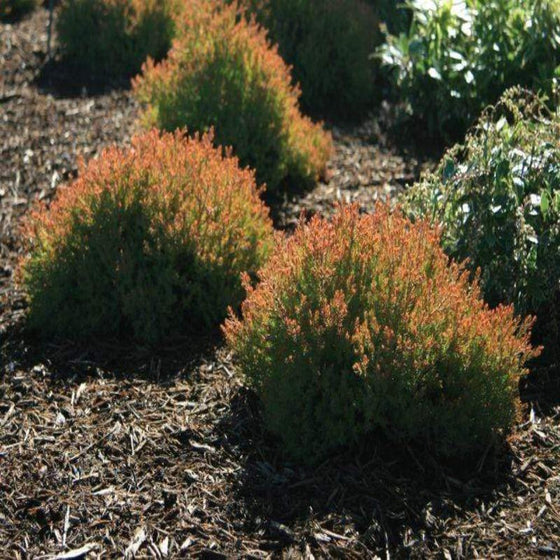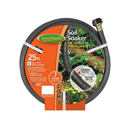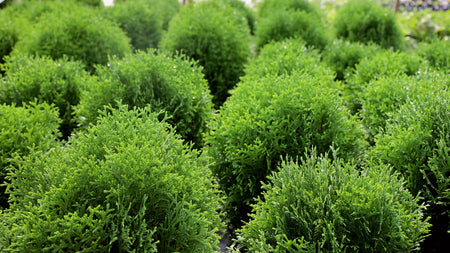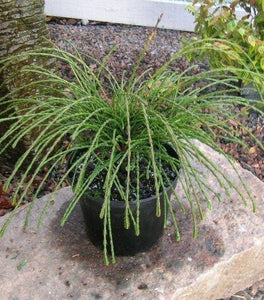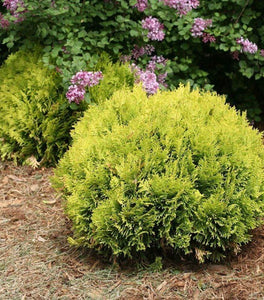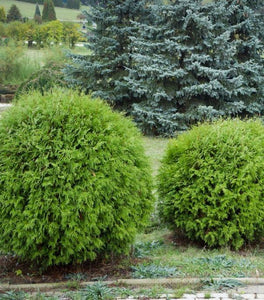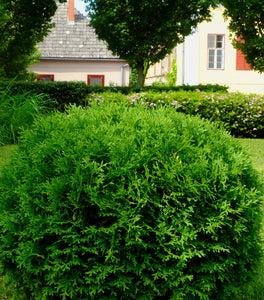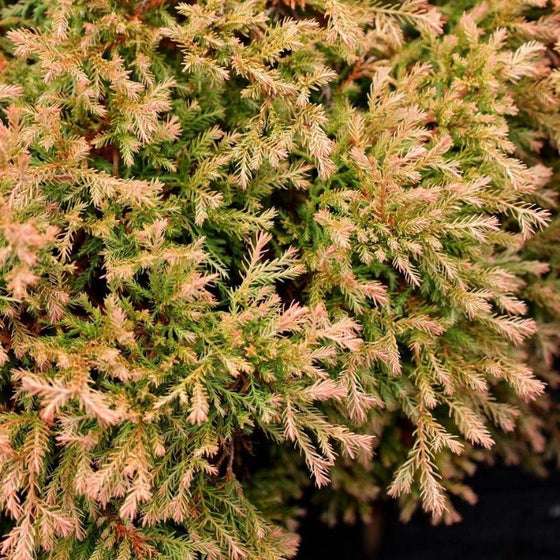
Images Depict Mature Plants
Fire Chief Arborvitae Shrubs for Sale Online
Fire Chief™ Arborvitae (Thuja occidentalis 'Congabe') is a striking, compact evergreen shrub known for its eye-catching, year-round color. This globe-shaped arborvitae features vibrant, feathery foliage that changes with the seasons, transitioning from bright green in spring to a rich golden-orange hue in fall, which deepens to a stunning red in winter. Growing to a height and spread of 3 to 4 feet, Fire Chief™ Arborvitae is perfect for adding texture and color to smaller garden spaces, foundation plantings, or as a border accent. Its natural globe shape requires minimal pruning, making it a low-maintenance choice for those seeking an attractive and easy-care addition to the landscape.
Fire Chief™ Arborvitae thrives in USDA hardiness zones 5 through 8, preferring full sun to partial shade. This adaptable shrub grows well in a variety of soil types as long as the soil is well-drained. Its slow to moderate growth rate ensures that it maintains its rounded form, providing year-round structure and interest to mixed borders, rock gardens, or container plantings. With its naturally compact size and unique coloration, Fire Chief™ Arborvitae works well in both formal and informal garden designs, adding a bright focal point or providing contrast against other green foliage. Its year-round color transition makes it a standout choice for those looking to introduce dynamic, seasonal interest to their garden.
In addition to its aesthetic qualities, Fire Chief™ Arborvitae is deer-resistant, making it an excellent choice for gardeners in areas with heavy deer activity. Once established, this hardy shrub also demonstrates good drought tolerance, further contributing to its low-maintenance appeal. For best results, water Fire Chief™ Arborvitae regularly during the first growing season to help establish a deep root system. Then, apply a layer of mulch around the base to retain moisture and regulate soil temperature. Whether planted in mass, as a low hedge, or as a specimen plant, Fire Chief™ Arborvitae delivers year-round beauty, vibrant color, and easy care, making it an exceptional addition to any landscape.
Fire Chief Arborvitae and Thuja Fire Chief refer to the same plant, officially known as Thuja occidentalis 'Congabe.' These names are often used interchangeably in the horticultural world to describe this compact, globe-shaped evergreen shrub known for its vibrant, year-round color. Regardless of the name used, both refer to the same cultivar that offers stunning seasonal foliage transitions, from bright green in spring to a fiery red in winter, making it a popular choice for various landscape applications.
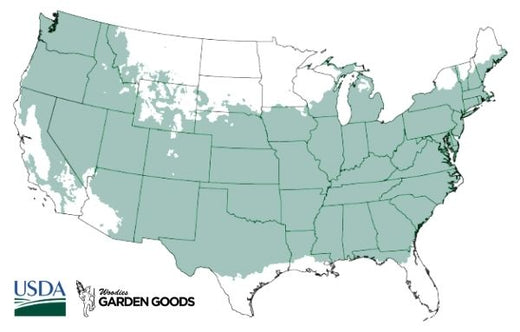
| Hardiness Zone: | 5-8 |
|---|---|
| Mature Height: | 3 to 4 feet |
| Mature width: | 3 to 4 feet |
| Classification: | evergreen shrub |
| Sunlight: | Full Sun |
| Habit: | Densely branched, Mounding |
| Foliage: | Bright Gold changing to Deep Red |
| Pruning Season: | Prune in late spring to maintain shape |
| Soil Condition: | Any well drained soil |
| Water Require: | Water well until established. |
| Uses: | Extremely attractive when used as in the mixed border, foundations, or planted in mass. |
How to Care for Fire Chief™ Arborvitae
Before you buy a Fire Chief™ Arborvitae, make sure to read about the recommended care instructions to keep this plant healthy and thriving.
How do I Plant a Fire Chief Arborvitae?
Planting a Fire Chief Arborvitae starts with selecting the right location to ensure healthy growth and vibrant color. Choose a site that offers full sun to partial shade, as Fire Chief Arborvitae will develop its best coloration with ample sunlight. The soil should be well-drained but moist, as this compact shrub does not tolerate standing water. To begin planting, dig a hole twice as wide and just as deep as the root ball to allow plenty of space for root expansion. Place the Fire Chief Arborvitae in the hole so that the top of the root ball is level with or slightly above the surrounding soil. Backfill with a mix of native soil and compost to provide the nutrients needed for healthy establishment, and water thoroughly to eliminate any air pockets and help the roots settle. After planting your Fire Chief Arborvitae, proper care is essential for establishing a strong root system. Water the newly planted shrub deeply at least once a week during the first growing season, particularly during hot or dry periods, to keep the soil consistently moist but not waterlogged. Adding a 2-3 inch layer of organic mulch around the base of the plant can help retain moisture, regulate soil temperature, and suppress weeds—just be sure to keep the mulch a few inches away from the trunk to prevent rot. If planting multiple Fire Chief Arborvitaes to form a border or hedge, space them about 3 to 4 feet apart to allow for their mature size and ensure good airflow between the plants. With proper planting and initial care, your Fire Chief Arborvitae will grow into a beautiful, colorful shrub that adds dynamic interest to your landscape year-round.
How do I water a Fire Chief Arborvitae?
Watering a Fire Chief Arborvitae properly is crucial for maintaining its vibrant, year-round color and overall health. During the first growing season, it's important to water your Fire Chief Arborvitae deeply and consistently, about once or twice a week, depending on weather conditions and soil moisture levels. Deep watering helps establish a strong root system and encourages roots to grow deeply into the soil, which increases the plant's drought tolerance over time. Always water at the base of the plant, ensuring that the root zone is thoroughly saturated, but be careful to avoid waterlogging, as Fire Chief Arborvitae prefers well-drained soil. Using a soaker hose or drip irrigation is a great way to provide slow, consistent moisture that will penetrate the soil deeply without causing runoff. Once Fire Chief Arborvitae is established, it becomes more drought-tolerant, but supplemental watering is still necessary during extended dry spells, especially in hot summer months. Check the top few inches of soil—if it feels dry to the touch, it’s time to water. Mulching around the base of the shrub with a 2-3 inch layer of organic mulch, such as bark or wood chips, will help retain soil moisture, regulate temperature, and reduce evaporation. During colder months, watering should be reduced but not entirely stopped; providing occasional moisture during dry winter periods helps prevent desiccation. Proper watering practices will ensure your Fire Chief Arborvitae maintains its dense, globe-shaped form and showcases its stunning seasonal color transitions, from bright green to golden orange to fiery red, throughout the year.
How do I Fertilize a Fire Chief Arborvitae?
Fertilizing a Fire Chief Arborvitae is important to maintain its vibrant foliage color and promote healthy growth throughout the year. The best time to fertilize is in early spring, just before new growth begins, using a balanced, slow-release fertilizer formulated for evergreen shrubs, such as a 10-10-10 or 12-4-8 blend. Spread the fertilizer evenly around the base of the shrub, extending out to the drip line, but make sure to keep it at least 6 inches away from the trunk to avoid burning the roots. This will provide essential nutrients like nitrogen, phosphorus, and potassium, which are necessary for lush, healthy foliage and vigorous growth. After applying the fertilizer, water the area thoroughly to help the nutrients soak into the soil and reach the root system effectively. To maintain the health and color of your Fire Chief Arborvitae, you can also add organic amendments such as compost or well-aged manure to improve the soil quality. Mulching around the base of the plant helps retain moisture and gradually enriches the soil as it breaks down, contributing to long-term nutrient availability. Avoid fertilizing in late summer or fall, as this can encourage new growth that may not harden off properly before winter, leaving it vulnerable to frost damage. A light feeding in mid-summer can be beneficial if the soil is nutrient-poor or if the shrub shows signs of slow growth. With proper fertilization, your Fire Chief Arborvitae will continue to thrive, showcasing its stunning year-round color changes, from bright green in spring to fiery red in winter, adding visual interest to your landscape.

How do I Prune a Fire Chief Arborvitae?
Pruning a Fire Chief Arborvitae is important for maintaining its natural, globe-shaped form and promoting healthy growth. The best time to prune Fire Chief Arborvitae is in late winter or early spring before new growth begins, allowing the plant to recover quickly and encouraging fresh, dense foliage. Use clean, sharp pruning shears to remove any dead, damaged, or diseased branches, cutting them back to healthy wood to improve the overall health of the shrub. Since Fire Chief Arborvitae is a compact, slow-growing variety, heavy pruning is usually unnecessary. Instead, focus on light trimming to keep the shrub tidy and well-shaped, which will help maintain its vibrant, year-round color and ensure a full, bushy appearance. If Fire Chief Arborvitae is being used as part of a low hedge or border, light pruning may also be necessary in late summer to keep a uniform shape and prevent any branches from growing out of proportion. When pruning, be careful not to cut too far into the old wood, as arborvitae may not produce new growth from these older areas, potentially leaving bare spots. Pruning the outer tips of branches encourages bushier growth, helping maintain the plant's dense, compact form. Avoid over-pruning, as this can stress the plant and reduce its natural appeal. With regular, gentle pruning, your Fire Chief Arborvitae will retain its attractive, rounded shape and showcase its beautiful color transitions, from bright green in spring to fiery red in winter, making it a striking feature in your garden.

